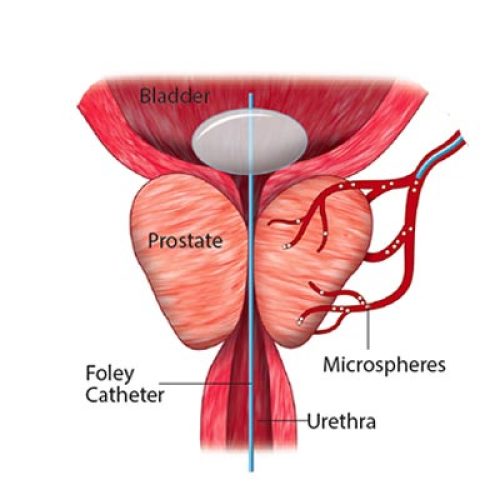Prostate Artery Embolization (PAE): A Minimally Invasive Treatment Option
Prostate artery embolization, often referred to as PAE, is a modern and minimally invasive treatment option for men dealing with urinary issues caused by an enlarged prostate. So, what exactly is PAE? In simple terms, it’s a procedure that helps reduce the size of the prostate gland by cutting off the blood supply to it. This can lead to relief from symptoms like frequent urination or difficulty starting and stopping urination. Many men wonder if there are better alternatives to traditional surgical treatments,
such as the transurethral resection of the prostate (TURP). PAE offers a promising solution without the need for major surgery. Instead of making large incisions, this procedure uses tiny incisions to access the arteries supplying blood to the prostate. This means less pain, a shorter recovery time, and fewer risks compared to more invasive surgeries.
You might be asking yourself: “Is PAE safe?” or “Will it really help my urinary problems?” The good news is that prostate artery embolization has been shown to be effective for many men suffering from lower urinary tract symptoms due to benign prostatic hyperplasia (BPH). Performed by skilled interventional radiologists, this outpatient procedure allows patients to return home on the same day, making it a convenient option for those seeking relief. If you’re looking for a treatment that minimizes discomfort while addressing your prostate issues, PAE could be the answer you’ve been searching for.
What is Prostate Artery Embolization?
Understanding the Prostate Gland and Benign Prostatic Hyperplasia (BPH)
The prostate gland is a small, walnut-sized organ located just below the bladder and in front of the rectum in men. It surrounds the urethra, which is the tube that carries urine and semen out of the body. The primary role of the prostate is to produce a fluid that nourishes and protects sperm, making it essential for male reproductive health. Additionally, the prostate helps regulate urine flow by contracting and relaxing around the urethra. As men age, many experience a condition known as benign prostatic hyperplasia (BPH), which is a non-cancerous enlargement of the prostate. This enlargement can lead to various urinary symptoms, including:
- Difficulty starting urination
- Frequent urination, especially at night (nocturia)
- Weak or interrupted urine flow
- A feeling of incomplete bladder emptying
These symptoms can significantly impact daily life and overall well-being.
The PAE Procedure
Prostate artery embolization (PAE) is a procedure designed to alleviate the symptoms of BPH. It works by blocking blood flow to specific areas of the prostate gland, which helps reduce its size over time. Here’s how the procedure is performed:
- Accessing the Arteries: The procedure begins with a small puncture in the groin area to access an artery.
- Using Imaging Technology: An imaging technique guides a catheter through the artery to reach the prostatic arteries that supply blood to the prostate.
- Embolization: Tiny particles are injected into these arteries to block blood flow. This process causes some areas of the prostate to shrink as they lose their blood supply.
PAE is considered a minimally invasive procedure, meaning it does not require large incisions or general anesthesia, making it less painful and allowing for quicker recovery compared to traditional surgical treatments like transurethral resection of the prostate (TURP). While TURP involves removing part of the prostate tissue through surgery, PAE focuses on reducing blood flow to help shrink the gland without major surgery.
Key Points
- The prostate gland plays a vital role in male reproductive health and urinary control.
- BPH can cause significant urinary symptoms that affect quality of life.
- PAE is a minimally invasive treatment option that targets prostatic arteries using imaging technology.
- Compared to TURP, PAE offers a less invasive approach with fewer complications and shorter recovery times.
If you’re experiencing symptoms related to BPH, understanding your options, including PAE, can help you make informed decisions about your treatment.
Who is a Candidate for PAE?
Prostate artery embolization (PAE) is a suitable treatment option for certain groups of men experiencing issues related to an enlarged prostate. Understanding who can benefit from this minimally invasive procedure is crucial for those seeking relief from urinary symptoms associated with benign prostatic hyperplasia (BPH). Here are the key factors that determine candidacy for PAE:
Suitability for PAE
- Patients with Moderate to Severe BPH Symptoms: Men who experience moderate to severe symptoms of BPH, such as difficulty urinating, frequent urination, or a weak urine stream, may find PAE to be an effective solution. If these symptoms significantly impact daily life and are not well controlled by medications, PAE can provide much-needed relief.
- Non-Surgical Option Seekers: Many men may prefer a non-surgical treatment option due to concerns about the risks and recovery associated with traditional surgeries like transurethral resection of the prostate (TURP). PAE offers a way to address prostate issues without the need for invasive surgery.
- Ineligibility Due to Medical Conditions: Some individuals may be ineligible for surgery due to existing medical conditions, such as advanced age, multiple health issues, or complications related to blood clotting. For these patients, PAE presents a viable alternative that minimizes risks while effectively treating BPH symptoms.
Consultation and Assessment
It is essential for potential candidates to consult with their healthcare provider to assess their overall health and suitability for the PAE procedure. During this consultation, doctors will evaluate:
- The severity of urinary symptoms and how they affect quality of life.
- Any existing medical conditions that may impact the safety or effectiveness of the procedure.
- The results of necessary tests, such as urine analysis and imaging studies, to rule out other conditions that could cause similar symptoms.
If you or someone you know is struggling with urinary issues related to an enlarged prostate, discussing the possibility of prostate artery embolization with a healthcare professional could be a significant step towards finding relief.
Benefits of Prostate Artery Embolization
Prostate artery embolization (PAE) offers several significant advantages for men suffering from symptoms of benign prostatic hyperplasia (BPH). This minimally invasive procedure is gaining popularity due to its effectiveness and the benefits it provides compared to traditional surgical options. Here are some key benefits of PAE:
Reduced Recovery Time Compared to Surgery
One of the most appealing aspects of PAE is the reduced recovery time. Unlike traditional surgical treatments, such as transurethral resection of the prostate (TURP), which often require longer hospital stays and extended recovery periods, PAE is performed on an outpatient basis. Most patients can return home the same day and resume normal activities within a few days. This quick recovery allows men to get back to their daily routines without prolonged downtime.
Avoidance of General Anesthesia
PAE does not require general anesthesia, which is commonly used in surgical procedures like TURP. Instead, local anesthesia or sedation is typically administered, making the procedure safer and more comfortable for patients. This approach minimizes the risks associated with general anesthesia, such as complications related to breathing or heart function, making PAE a safer choice for many individuals.
Lower Risk of Complications
The risk of complications associated with PAE is significantly lower than that of traditional surgery. Studies have shown that PAE has a reduced incidence of adverse events compared to TURP. For example, complications such as urinary incontinence and sexual dysfunction are less common with PAE, making it an attractive option for men concerned about these potential side effects.
Maintains Sexual and Urinary Function
One of the major concerns for men considering treatment for BPH is the potential impact on sexual function. PAE has been shown to preserve both sexual and urinary function effectively. Unlike some surgical treatments that may lead to erectile dysfunction or retrograde ejaculation, PAE minimizes these risks, allowing men to maintain their quality of life post-procedure.
A Safer and Effective Treatment Option
Overall, prostate artery embolization is considered a safer and effective treatment option for managing symptoms related to BPH. Its minimally invasive nature, combined with a lower risk of complications and preservation of sexual function, makes it a compelling choice for many men seeking relief from urinary symptoms. If you’re experiencing issues related to an enlarged prostate, discussing the benefits of prostate artery embolization with your healthcare provider can help you determine if this treatment is right for you. With its numerous advantages, PAE could be the solution you’ve been looking for to regain comfort and improve your quality of life.
The PAE Procedure: What to Expect
Before the Procedure
Before undergoing prostate artery embolization (PAE), patients will have a pre-procedure consultation with their healthcare provider. This appointment is crucial for evaluating whether PAE is the right treatment option. During this consultation, several imaging tests may be conducted, such as CT scans or MRIs, to assess the prostate gland and the surrounding vascular anatomy. These tests help identify the size of the prostate and ensure that there are no other conditions causing similar urinary symptoms. Interventional radiologists will evaluate various factors, including:
- The severity of urinary symptoms
- Prostate volume and shape
- Any existing medical conditions that could affect the procedure’s safety or effectiveness
- Results from tests like urinalysis and prostate-specific antigen (PSA) levels to rule out prostate cancer
This thorough evaluation ensures that patients are adequately prepared for the procedure and helps in planning the best approach for each individual.
During the Procedure
On the day of the procedure, patients can expect a straightforward process. PAE is typically performed as an outpatient procedure, meaning patients can go home on the same day. Here’s what happens during the procedure:
- Catheter Insertion: An interventional radiologist will insert a small catheter into an artery, usually in the wrist or groin. This catheter is then carefully guided through the blood vessels to reach the prostatic arteries, which supply blood to the prostate gland.
- Guided by Imaging: The entire process relies heavily on imaging technology, such as fluoroscopy (a type of real-time X-ray), to ensure precise placement of the catheter. This guidance is crucial for targeting only the arteries supplying blood to the prostate while avoiding other surrounding structures.
- Duration: The procedure usually takes about 1 to 2 hours to complete. Patients are monitored closely throughout this time to ensure their safety and comfort.
After the Procedure
Following PAE, patients will enter a recovery phase where they can expect some mild discomfort, which is normal after any medical procedure. Here’s what to anticipate post-procedure:
- Recovery Time: Most patients can go home within a few hours after the procedure. While some may experience mild pain or cramping in the pelvic area, this typically resolves quickly.
- Post-Procedure Care: Patients are often advised to rest and avoid strenuous activities for a short period after returning home. Pain relief medications may be prescribed if necessary.
- Common Symptoms: Some commonly experienced symptoms after PAE include mild discomfort, frequent urination, or minor bleeding. These symptoms usually subside within a few days.
- Symptom Improvement Timeline: Many patients begin to notice improvement in their urinary symptoms within a few days following PAE. However, it may take several weeks for optimal results as the prostate gradually shrinks in response to reduced blood flow.
Understanding what to expect before, during, and after the PAE procedure can help alleviate any concerns and prepare patients for a smoother experience. If you’re considering this treatment for BPH symptoms, discussing these details with your healthcare provider can provide valuable insights tailored to your specific situation.
Risks and Side Effects of Prostate Artery Embolization
While prostate artery embolization (PAE) is considered a safe and effective treatment for benign prostatic hyperplasia (BPH), it is essential to be aware of potential risks and side effects. The minimally invasive nature of PAE significantly reduces many of the risks associated with traditional surgical procedures, making it an appealing option for many patients. Here’s what you need to know about the potential side effects and the overall safety of the procedure.
Potential Side Effects
- Minor Discomfort in the Groin Area: After the procedure, patients may experience some mild discomfort in the groin area where the catheter was inserted. This discomfort is usually temporary and can be managed with over-the-counter pain relief medications.
- Temporary Urinary Issues: Some patients might encounter temporary urinary symptoms, such as increased frequency of urination or mild dysuria (painful urination). These symptoms typically resolve within a few days as the body adjusts following the procedure.
- Rare Complications: Although PAE is generally safe, there are rare complications that can occur. These include:
- Infection: As with any medical procedure, there is a small risk of infection at the catheter insertion site.
- Non-target Embolization: This occurs when particles intended for the prostate inadvertently block blood flow to other nearby tissues. However, this is extremely rare when the procedure is performed by experienced interventional radiologists.
Emphasizing Safety
The safety record of prostate artery embolization is noteworthy. Studies have shown that PAE has a lower rate of complications compared to traditional surgical treatments like transurethral resection of the prostate (TURP). For instance, research indicates that PAE has significantly fewer adverse events, including issues like urinary incontinence and erectile dysfunction, which can be common with more invasive surgeries.
while there are some potential side effects associated with PAE, its minimally invasive nature greatly reduces overall risks. The procedure has been shown to maintain a strong safety profile while effectively addressing symptoms related to BPH. If you are considering PAE as a treatment option, discussing these risks and benefits with your healthcare provider can help you make an informed decision tailored to your specific needs.
How Much Does Prostatic Artery Embolization Cost in India?
The cost of prostate artery embolization (PAE) in India can vary significantly based on several factors, including the location of the hospital or clinic, the expertise of the doctor, and the technology used during the procedure. On average, patients can expect to pay between ₹91,000 and ₹2,00,000 for the PAE procedure.
Estimated Cost Ranges
- Mumbai: The average cost for PAE ranges from ₹1,50,000 to ₹2,00,000. This variation depends on the specific hospital and the services provided.
- General Estimates: Other sources indicate that costs can be as low as ₹91,000 and can go up to ₹1,50,000, depending on various factors.
Factors Influencing Cost
Several factors can influence the overall cost of prostate artery embolization:
- Hospital/Clinic Location: The city and specific facility where the procedure is performed can greatly affect pricing. Urban centers may have higher costs due to increased demand and operational expenses.
- Doctor Expertise and Facility Technology: The experience of the interventional radiologist performing the procedure and the technology available at the facility can also impact costs. Highly skilled doctors or advanced medical equipment may lead to higher fees.
- Severity of Condition: The complexity of each individual case may necessitate additional procedures or longer recovery times, which can increase costs.
- Insurance Coverage: Depending on individual insurance plans, some costs may be covered, making it essential for patients to check their coverage options.
Cost-Effectiveness Compared to Surgical Options
One of the significant advantages of PAE is its potential to be more cost-effective than traditional surgical treatments like transurethral resection of the prostate (TURP). While TURP may involve higher direct costs due to hospitalization and longer recovery times, PAE is often performed as an outpatient procedure. This means:
- No hospital stay is required.
- Patients typically return home on the same day.
- Reduced overall healthcare costs due to fewer complications and a quicker recovery process.
while the cost of prostatic artery embolization in India varies based on multiple factors, it remains a viable and often more affordable alternative to surgical options for treating BPH symptoms. If you’re considering PAE as a treatment option, discussing potential costs with your healthcare provider can help you better understand your financial commitment and insurance coverage.
PAE vs. TURP: Choosing the Right Treatment Option
When it comes to treating benign prostatic hyperplasia (BPH), two common options are prostate artery embolization (PAE) and transurethral resection of the prostate (TURP). Both procedures aim to relieve urinary symptoms caused by an enlarged prostate, but they differ significantly in terms of invasiveness, risks, recovery times, and patient preferences. Here’s a brief comparison to help you understand which treatment might be right for you.
Invasiveness and Risks
- Prostate Artery Embolization (PAE): PAE is a minimally invasive procedure that involves blocking blood flow to the prostate through small incisions, usually performed under local anesthesia. This approach significantly reduces the risk of complications compared to more invasive surgeries. The overall risk of major complications with PAE is around 1%, making it a safer choice for many patients.
- Transurethral Resection of the Prostate (TURP): TURP is a more invasive surgical procedure that requires general or spinal anesthesia. It involves removing part of the prostate tissue to relieve urinary obstruction. This method carries higher risks, including bleeding, infection, and potential side effects such as sexual dysfunction and urinary incontinence.
Recovery Times
- Recovery After PAE: One of the major advantages of PAE is its quick recovery time. Most patients can return home the same day and resume normal activities within a few days. This outpatient procedure allows for minimal disruption to daily life.
- Recovery After TURP: In contrast, TURP typically requires a hospital stay of 1 to 3 days, with a recovery period that can extend from 3 to 6 weeks. Patients may experience more significant postoperative discomfort and a longer time before returning to their usual routines.
Patient Preferences and Medical Eligibility
- Patient Preferences: Many patients prefer PAE due to its minimally invasive nature and lower risks associated with recovery. For those who are anxious about surgery or have health conditions that make surgery riskier, PAE presents an appealing alternative.
- Medical Eligibility: Not all patients are suitable candidates for TURP, particularly those with larger prostates (over 80 mL) or older adults who may face higher surgical risks. In such cases, PAE can be a viable option for managing BPH symptoms without the complications associated with traditional surgery.
both PAE and TURP have their benefits and drawbacks. While TURP has historically been considered the “gold standard” for BPH treatment, advances in medical technology have made PAE a strong contender as a safer and effective alternative. Patients should discuss their specific symptoms, medical history, and treatment preferences with their healthcare provider to determine which option is best suited for their individual needs. If you’re considering treatment for BPH, understanding the differences between these procedures can empower you to make an informed decision that aligns with your health goals and lifestyle.
Why Choose Midas Care Clinic for PAE?
When considering prostate artery embolization (PAE) as a treatment option for benign prostatic hyperplasia (BPH), choosing the right clinic is crucial for ensuring a successful outcome. At Midas Care Clinic, we pride ourselves on offering exceptional care and advanced treatment options. Here are several reasons why you should consider us for your PAE procedure:
Experienced Interventional Radiologists
Our team consists of highly skilled and experienced interventional radiologists who specialize in performing PAE. With extensive training and expertise, they utilize the latest techniques to ensure the procedure is safe and effective. Their commitment to patient care means you will receive personalized attention throughout your treatment journey.
State-of-the-Art Imaging and Surgical Tools
At Midas Care Clinic, we use state-of-the-art imaging technology and surgical tools to perform PAE. This advanced equipment allows our radiologists to precisely target the prostatic arteries, minimizing risks and enhancing the effectiveness of the procedure. By employing cutting-edge technology, we aim to provide the best possible outcomes for our patients.
Comprehensive Care from Consultation to Follow-Up
We believe in offering comprehensive care that extends beyond just the procedure itself. From your initial consultation through to follow-up appointments, our team is dedicated to ensuring you feel supported at every step. We take the time to address your concerns, explain the procedure in detail, and monitor your recovery closely to ensure optimal results.
Affordable Pricing and Personalized Treatment Plans
Understanding that healthcare costs can be a concern, Midas Care Clinic strives to offer affordable pricing for our PAE services. We provide transparent pricing structures and work with you to create a personalized treatment plan that fits your needs and budget. Our goal is to make high-quality care accessible without compromising on safety or effectiveness.
Choosing Midas Care Clinic for your prostate artery embolization means opting for a facility that prioritizes patient safety, comfort, and satisfaction. If you are considering PAE as a treatment option for BPH, contact us today to schedule a consultation and learn more about how we can help improve your quality of life.
Book Your Consultation for Prostate Artery Embolization Near Me
If you’re considering prostate artery embolization (PAE) as a treatment option for benign prostatic hyperplasia (BPH), the experts at Midas Care Clinic are here to help. Our team of experienced interventional radiologists is dedicated to providing you with personalized care and support throughout your treatment journey.
Why Consult with Us?
At Midas Care Clinic, we understand that each patient’s needs are unique. Our specialists will take the time to discuss your symptoms, evaluate your medical history, and determine if PAE is the right choice for you. We are committed to ensuring you feel comfortable and informed every step of the way.
Contact Information and Booking Options
To book your consultation or to learn more about prostate artery embolization, please reach out to us using the following contact details:
- Phone: +91-9209232601
- Email: midasclinicvasai@gmail.com
- Address: Midas Diagnostic & Vascular Clinic,Ground Floor G1/G2, Gajanan Society, Ambadi Rd, opposite Carmel Classes, near Chaphekar Hospital, Shastri Nagar, Vishal Nagar, Vasai West, Vasai-Virar, Maharashtra 401202.
You can also visit our website to fill out a contact form or schedule an appointment online. Our clinic operates Monday to Sunday from 09:00 AM to 09:00 PM, making it convenient for you to find a time that works best. Taking the first step towards relief from your urinary symptoms is easy. Contact us today to book your consultation for prostate artery embolization near you and discover how we can help improve your quality of life.
FAQs
1:What is the success rate of PAE?
Ans: The success rate of prostate artery embolization (PAE) is quite high, with studies indicating that approximately 80-90% of patients experience significant improvement in their urinary symptoms after the procedure. Many men report a reduction in the frequency of urination and an overall enhancement in their quality of life. The minimally invasive nature of PAE, combined with its effective results, makes it a popular choice among patients seeking relief from benign prostatic hyperplasia (BPH).
Q2:Is PAE covered by insurance?
Ans: In many cases, prostate artery embolization is covered by health insurance, but coverage can vary widely depending on the specific plan and provider. It is advisable for patients to check with their insurance company to understand their benefits regarding PAE. Discussing the procedure with your healthcare provider can also help clarify whether it is classified as a medically necessary treatment under your plan.
Q3:How long does recovery take?
Ans: Recovery from PAE is generally quick compared to traditional surgical options like transurethral resection of the prostate (TURP). Most patients can return to normal activities within 1 to 2 weeks after the procedure. While some may experience mild discomfort or temporary urinary issues immediately following the treatment, these symptoms typically resolve within a few days. Patients are usually advised to rest for the first 24 to 48 hours and avoid strenuous activities during this time.
Q4:Is PAE painful?
Ans: The procedure itself is performed under local anesthesia or sedation, so most patients do not experience significant pain during prostate artery embolization. After the procedure, some individuals may feel mild discomfort in the groin area where the catheter was inserted, but this discomfort is usually manageable with over-the-counter pain relief medications. Overall, PAE is considered a low-pain option compared to more invasive surgical treatments.
Q5:Can PAE improve my quality of life?
Ans: Yes, many patients report a significant improvement in their quality of life after undergoing prostate artery embolization. By effectively reducing prostate size and alleviating symptoms such as frequent urination and difficulty starting urination, PAE allows men to regain comfort and confidence in their daily activities. The quick recovery time and minimal side effects further enhance the overall experience for patients seeking relief from BPH symptoms. If you have more questions about prostate artery embolization or want to explore whether this treatment is right for you, consider scheduling a consultation with our experts at Midas Care Clinic. We are here to provide personalized care and support throughout your treatment journey.
Our Services
X-Ray | Sonography | Prostate Artery Embolization In Vasai | Deep Vein Thrombosis Specialists | Peripheral Artery Disease Specialist | Best Diagnostic Center In Vasai








